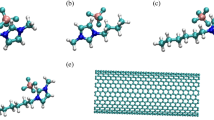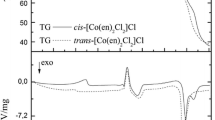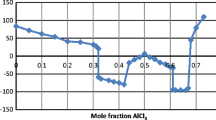Abstract
The solubility of 1-butyl-3-methylimidazolium octylsulfate, [BMIM][OcSO4], has been determined in hydrocarbon (n-hexane, n-heptane, n-octane or n-decane) solutions and alcohol (methanol, 1-butanol, 1-hexanol, 1-octanol or 1-decanol) solutions. Densities and excess molar volumes, V E m, have been determined for 1-methyl-3-methylimidazolium methylsulfate, [MMIM][CH3SO4], solutions with an alcohol (methanol, ethanol or 1-butanol) and with water; for 1-butyl-3-methylimidazolium methylsulfate, [BMIM][CH3SO4], with an alcohol (methanol, ethanol, 1-butanol, 1-hexanol, 1-octanol or 1-decanol) and with water; and for 1-butyl-3-methylimidazolium octylsulfate, [BMIM][OcSO4], with an alcohol (methanol, 1-butanol, 1-hexanol, 1-octanol or 1-decanol) at 298.15 K and atmospheric pressure. The systems exhibit very negative or positive molar excess volumes, V E m, and negative or positive excess molar enthalpies, H E m, as predicted by the Flory–Benson–Treszczanowicz (FBT) model. Our experimental V E m data were used for the description of H E m for solutions of [MMIM][CH3SO4] with the alcohols under study. The simple Prigogine–Flory–Paterson (PFP) model, without including the association of the alcohol, gave slightly worse results. Negative molar excess volumes, V E m, are attributed to hydrogen bonding between the short chain alcohols and ionic liquid and to efficient packing effects. The FBT model overestimates self-association of the alcohol in the solutions under study and shifts the calculated curves to higher alcohol mole fractions. The thermophysical characteristics of [BMIM][OcSO4] were also examined by differential scanning calorimetry (DSC).
Similar content being viewed by others
References
R. Kato and J. Gmehling, Activity Coefficients at Infinite Dilution of various Solutes in the Ionic Liquids [MMIM][CH3SO4], [MMIM][CH3OC2H4SO4], [MMIM][(CH3)2PO4], [C5H5NC2H5][(CF3SO2)2N] and [C5H5NH][C2H5OC2H4OSO3]. Fluid Phase Equilib. 226, 37–44 (2004).
R. Kato, M. Krummen, and J. Gmehling, Measurement and Correlation of Vapor-Liquid Equilibria and Excess Enthalpies of Binary Systems Containing Ionic Liquids and Hydrocarbons. Fluid Phase Equilib. 224, 47–54 (2004).
C. P. Fredlake, J. M. Crostwaite, D. G. Hert, S. N. V. K. Akai, and J. F. Brennecke, Thermophysical Properties of Imidazolium-Based Ionic Liquids. J. Chem. Eng. Data 49, 954–964 (2004).
J. M. Crosthwaite, S. N. V. Akai, E. J. Maginn, and J. F. Brennecke, Liquid Phase Behavior of Imidazolium-Based Ionic Liquids with Alcohols. J. Phys. Chem. B 108, 5113–5119 (2004).
U. Domańska and A. Marciniak, Solubility of Ionic Liquid [emim][PF6] in Alcohols. J. Phys. Chem. B 108, 2376–2382 (2004).
J. M. Crosthwaite, S. N. V. Aki, E. J. Maginn, and J. F. Brennecke, Liquid Phase Behavior of Imidazolium-based Ionic Liquids with Alcohols: Effect of Hydrogen Bonding and Non-polar Interactions. Fluid Phase Equilib. 228–229, 303–309 (2005).
U. Domańska and A. Marciniak, Liquid Phase Behaviour of 1-Hexyloxymethyl-3-methyl-imidazolium-based Ionic Liquids with Hydrocarbons: The Influence of Anion. J. Chem. Thermodyn. 37, 577–585 (2005).
J. Łacha, J. Szydłowski, V. Najdanovic-Visak, L. P. N. Rebelo, K. R. Seddon, M. Nunes da Ponte, J. M. S. S. Esperanca, and H. J. R. Guedes, Evidence for Lower Critical Solution Behavior in Ionic Liquid Solutions. J. Am. Chem. Soc. 127, 6542–6543 (2005).
L. P. N. Rebelo, J. N. Canongia Lopes, J. M. S. S. Esperanca, and E. Filipe, On the Critical Temperature, Normal Boiling Point, and Vapor Pressure of Ionic Liquids. J. Phys. Chem. B 109, 6040–6043 (2005).
R. Kato and J. Gmehling, Systems with Ionic Liquids: Measurement of VLE and γ∞ Data and Prediction of their Thermodynamic Behavior using Original UNIFAC, mod. UNIFAC(Do) and COSMO-RS(01). J. Chem. Thermodyn. 37, 603–619 (2005).
T. M. Letcher, A. Marciniak, M. Marciniak, and U. Domańska, Determination of Activity Coefficients at Infinite Dilution of Solutes in the Ionic Liquid 1-Butyl-3-methylimidazolium Octyl Sulfate Using Gas-Liquid Chromatography at a Temperature of 298.15 K, 313.15 K, or 328.15 K. J. Chem. Eng. Data 50, 1294–1298 (2005).
A. Heintz, J. K. Lehmann, and C. Wertz. Thermodynamic Properties of Mixtues Containing Ionic Liquids. 3. Liquid–Liquid Equilibria of Binary Mixtures of 1-Ethyl-3-methylimidazolium Bis(trifluoromethylsulfonyl)imide with Propan-1-ol, Butan-1-ol, and Pentan-1-ol. J. Chem. Eng. Data 48, 472–474 (2003).
C.-T. Wu, K. N. Marsh, A. V. Deev, and J. A. Boxall, Liquid–Liquid Equilibria of Room-Temperature Ionic Liquids and Butan-1-ol. J. Chem. Eng. Data 48, 486–491 (2003).
U. Domańska, A. Pobudkowska, and F. Eckert, Liquid-Liquid Equilibria in the Binary Systems (1,3-Dimethylimidazolium, or 1-Butyl-3-methylimidazolium Methylsulfate + Hydrocarbons). Green Chem. (2005) DOI: 10.1039/B514521J.
U. Domańska, A. Pobudkowska, and F. Eckert, (Liquid + Liquid) Phase Equilibria of 1-Alkyl-3-methylimidazolium Methylsylfate with Alcohols, or Ethers, or Ketones. J. Chem. Thermodyn. (2005) DOI: 10.1016/j.jct.2005.07.024.
S. Wingefors, Development of the Correlation Between the Non-polar Solubility Parameter. Refractive Index and Molecular Structure. II. Aliphatic Ethers and Alcohols. J. Chem. Tech. Biotechnol. 31, 530–534 (1981).
A. Liu, K. Pusicha, A. M. Demiriz, and F. Kohler, Model for Alkanol + Alkane Mixtures: Extension and Experimental Verification. J. Solution Chem. 20, 39–56 (1991).
J. D. Meyer and E. E. Reid, Isomorphism and Alternation in the Melting Points of the Normal Alcohols, Acetates, Bromides, Acids and Ethyl Esters from C10 to C18. J. Am. Chem. Soc. 55, 1574–1584 (1933).
P. Scharlin, K. Steinby, and U. Domańska, Volumetric Properties of Binary Mixtures of N,N-Dimethylformamide with Water or Water-d 2 at Temperature from 277.13 K to 318.15 K. J. Chem. Thermodyn. 34, 927–957 (2002).
A. J. Treszczanowicz and G. C. Benson, Excess Volumes of Alkanol + Alkane Binary Systems in Terms of an Association Model with a Flory Contribution Term. Fluid Phase Equilib. 23, 117–135 (1985).
A. J. Treszczanowicz and G. C. Benson, Excess Volumes of Cycloalkanol + Cycloalkane Binary Systems in Terms of an Association Solution Theory with a Flory Equation of State Contribution. Thermochim. Acta 179, 39–47 (1991).
P. J. Flory, Statistical Thermodynamics of Liquid Mixtures. J. Am. Chem. Soc. 87, 1833–1835 (1965).
A. Abe and P. J. Flory, The Thermodynamic Properties of Mixtures of Small, Nonpolar Molecules. J. Am. Chem. Soc. 87, 1838–1842 (1965).
R. A. Orwoll and P. J. Flory, Equation of State Parameters for Normal Alkanes. Correlation with Chain Length. J. Am. Chem. Soc. 89, 6822–6825 (1967).
U. Domańska, The Excess Molar Volumes of (a Hydrocarbon + a Branched Chain Ether) at 298.15 K and 308.15 K and the Application of the PFP Theory. Fluid Phase Equilib. 130, 207–222 (1997).
T. M. Letcher, and U. Domańska, Excess Enthalpies of (2,2,4-Trimethylpentane or 1-Heptane or Hexane or Toluene + Methyl 1,1-Dimethylethyl Ether) and (1-Heptene or 1-Hexene or Toluene + 1,1-Dimethylpropyl Ether) at the Temperature 298.15 K and 308.15 K. J. Chem. Thermodyn. 29, 721–730 (1997).
T. M. Letcher and R. C. Baxter, Application of the Prigogine–Flory–Patterson Theory. Part I. Mixtures of n-Alkanes with Bicyclic Compounds, Benzene, Cyclohexane and n-Hexane. J. Solution Chem. 18, 65–79 (1989).
H. Kehiaian and A. Treszczanowicz, Thermodynamics of Chemically Reacting Mixtures. Excess Free Enthalpy of Athermal Associated Mixtures of the Mecke-Kempter type. Bull. Acad. Polon. Sci. Ser. Sci. Chim. 16, 445–449 (1968).
H. Funke, M. Wetzel, and A. Heintz, New Applications of the ERAS Model. Thermodynamics of Amine + Alkane and Alcohol + Amine Mixtures. Pure Appl. Chem. 61, 1429–1439 (1989).
T. M. Letcher, J. Achwa, and U. Domańska, The Excess Molar Volumes, and Excess Molar Enthalpies of (N-Methyl-2-pyrrolidinone + an Alkanol) at the Temperature 298.15 K. J. Chem. Thermodyn. 34, 1581–1599 (2002).
Author information
Authors and Affiliations
Corresponding author
Additional information
Presented at the 21st ESAT European Symposium on Applied Thermodynamics, Jurata, Poland, June 1, 2006 to June 5, 2006.
Electronic supplementary material
Rights and permissions
About this article
Cite this article
Domańska, U., Pobudkowska, A. & Wiśniewska, A. Solubility and Excess Molar Properties of 1,3-Dimethylimidazolium Methylsulfate, or 1-Butyl-3-Methylimidazolium Methylsulfate, or 1-Butyl-3-Methylimidazolium Octylsulfate Ionic Liquids with n-Alkanes and Alcohols: Analysis in Terms of the PFP and FBT Models1 . J Solution Chem 35, 311–334 (2006). https://doi.org/10.1007/s10953-005-9002-0
Received:
Revised:
Published:
Issue Date:
DOI: https://doi.org/10.1007/s10953-005-9002-0




